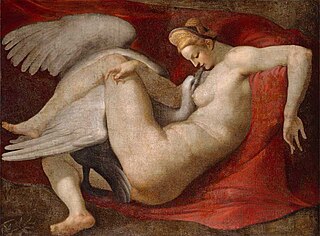
Leda and the Swan is a story and subject in art from Greek mythology in which the god Zeus, in the form of a swan, seduces Leda. According to later Greek mythology, Leda bore Helen and Polydeuces, children of Zeus, while at the same time bearing Castor and Clytemnestra, children of her husband Tyndareus, the King of Sparta. In the W. B. Yeats version, it is subtly suggested that Clytemnestra, although being the daughter of Tyndareus, has somehow been traumatized by what the swan has done to her mother. According to many versions of the story, Zeus took the form of a swan and seduced Leda on the same night she slept with her husband King Tyndareus. In some versions, she laid two eggs from which the children hatched. In other versions, Helen is a daughter of Nemesis, the goddess who personified the disaster that awaited those suffering from the pride of Hubris.
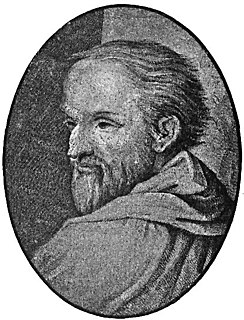
Antonio Allegri da Correggio, usually known as just Correggio, was the foremost painter of the Parma school of the High Italian Renaissance, who was responsible for some of the most vigorous and sensuous works of the 16th century. In his use of dynamic composition, illusionistic perspective and dramatic foreshortening, Correggio prefigured the Baroque art of the 17th century and the Rococo art of the 18th century. He is considered a master of chiaroscuro.

In Greek mythology, Leda was an Aetolian princess who became a Spartan queen. Her myth gave rise to the popular motif in Renaissance and later art of Leda and the Swan.
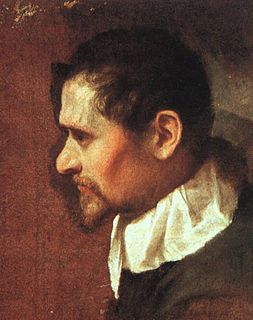
Annibale Carracci was an Italian painter and instructor, active in Bologna and later in Rome. Along with his brother and cousin, Annibale was one of the progenitors, if not founders of a leading strand of the Baroque style, borrowing from styles from both north and south of their native city, and aspiring for a return to classical monumentality, but adding a more vital dynamism. Painters working under Annibale at the gallery of the Palazzo Farnese would be highly influential in Roman painting for decades.

Marcantonio Franceschini was an Italian painter of the Baroque period, active mostly in his native Bologna. He was the father and teacher of Giacomo Franceschini.
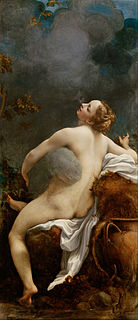
Jupiter and Io is a painting by the Italian High Renaissance artist Antonio Allegri da Correggio. It is housed in the Kunsthistorisches Museum of Vienna, Austria.
Carlo Antonio Porporati was an Italian engraver and painter.

The story of Leda and the Swan was the subject of two compositions by Leonardo da Vinci from perhaps 1503–10. Neither survive as paintings by Leonardo, but there are a number of drawings for both by him, and copies in oils, especially of the second composition, where Leda stands.

Leda Atomica is a painting by Salvador Dalí, made in 1949. The picture depicts Leda, the mythological queen of Sparta, with the swan. Leda is a frontal portrait of Dalí's wife, Gala, who is seated on a pedestal with a swan suspended behind and to her left. Different objects such as a book, a set square, two stepping stools and an egg float around the main figure. In the background on both sides, the rocks of Cap Norfeu define the location of the image.
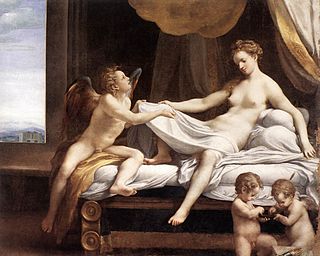
Danaë is a painting by the Italian Renaissance artist Correggio, executed around 1531 and housed in the Galleria Borghese in Rome.

Adoration of the Christ Child is an oil on canvas painting by the Italian Renaissance artist Correggio, dating from around 1526 and housed in the Uffizi Gallery of Florence, Italy.

The Martyrdom of Four Saints is an oil on canvas painting by the Italian Renaissance artist Correggio, dating from around 1524 and housed in the Galleria Nazionale of Parma, Italy.

Ganymede Abducted by the Eagle is a painting by the Italian late Renaissance artist Antonio da Correggio. It is housed in the Kunsthistorisches Museum, Vienna, Austria.

The Madonna and Child with Sts Jerome and Mary Magdalen is an oil on canvas painting by the Italian Renaissance artist Correggio dating from around 1528 and housed in the Galleria Nazionale of Parma, Italy.

Leda and the Swan, by Peter Paul Rubens, who painted two versions of this subject. The first was completed in 1601 and the second in 1602.

Leda and the Swan is an oil on canvas painting from 1530–31 by the Italian painter Correggio, now in the Gemäldegalerie in Berlin. It shows three scenes of Leda's seduction by Jupiter who has taken the form of a swan. Their first meeting is shown on the right hand side and their lovemaking in the centre, where Leda sits with the swan between her thighs, guiding him with her left hand. They are accompanied to their left by Cupid with his bow and two cupids with flutes. The third scene is the swan flying away whilst Leda gets dressed. Leda and the Swan was a common subject in 16th-century art.

Leda and the Swan is a lost tempera on canvas painting by Michelangelo, produced in 1530 but now only surviving in copies and variants. The work depicted the Greek myth of Leda and the Swan.

The Madonna and Child with the Infant John the Baptist is a 1518 oil on panel painting by Antonio da Correggio. Stylistically it is closest to the frescoes Correggio produced for the Camera di San Paolo and the fact that it was a model for Michelangelo Anselmi suggests that Correggio painted it in Parma. It is the work in which Leonardo da Vinci's influence on Correggio is most obvious - it forms a free variation on Leonardo's The Virgin of the Rocks.

The Allegory of Virtue is an oil on canvas painting by Correggio dating to around 1531 and measuring 149 by 88 cm. It and Allegory of Vice were painted as a pair for the studiolo of Isabella d'Este, with Vice probably the second of the two to be completed. This hypothesis is since only one sketch survives for Vice, unlike Virtue, for which two preparatory studies survive, along with a near-complete oil sketch - this suggests Correggio had become more proficient after the difficult gestation of Virtue.
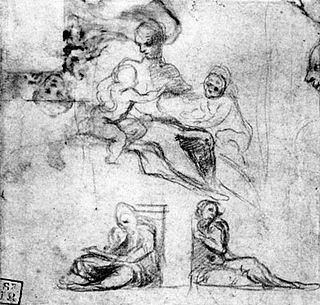
The Casalmaggiore Madonna is a lost oil on canvas painting by Correggio, measuring 28 by 24 cm and painted around 1522.

















